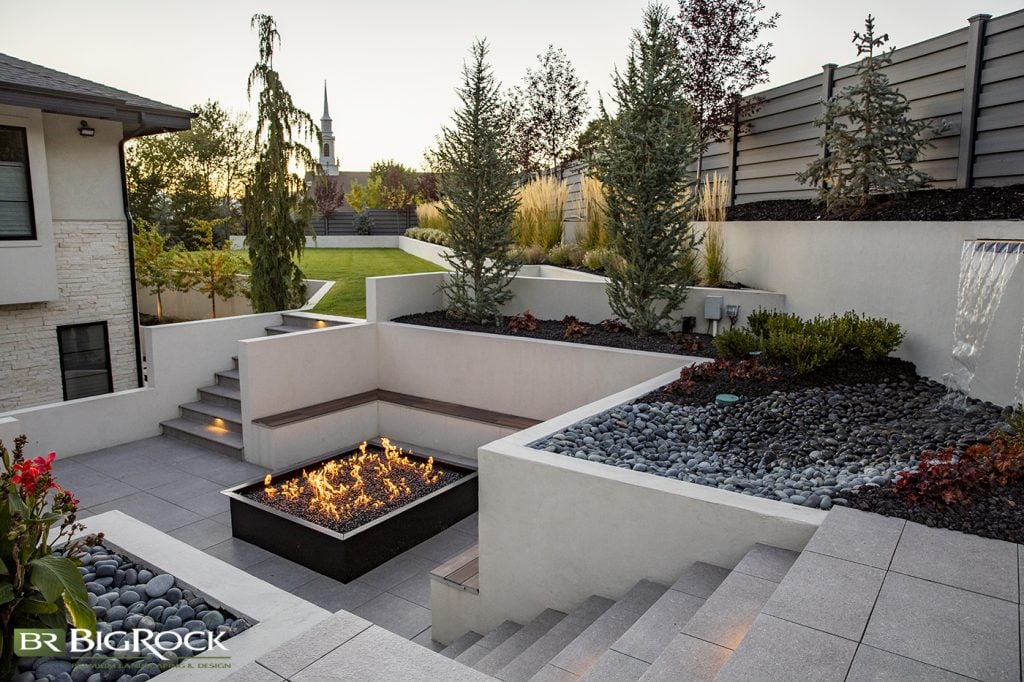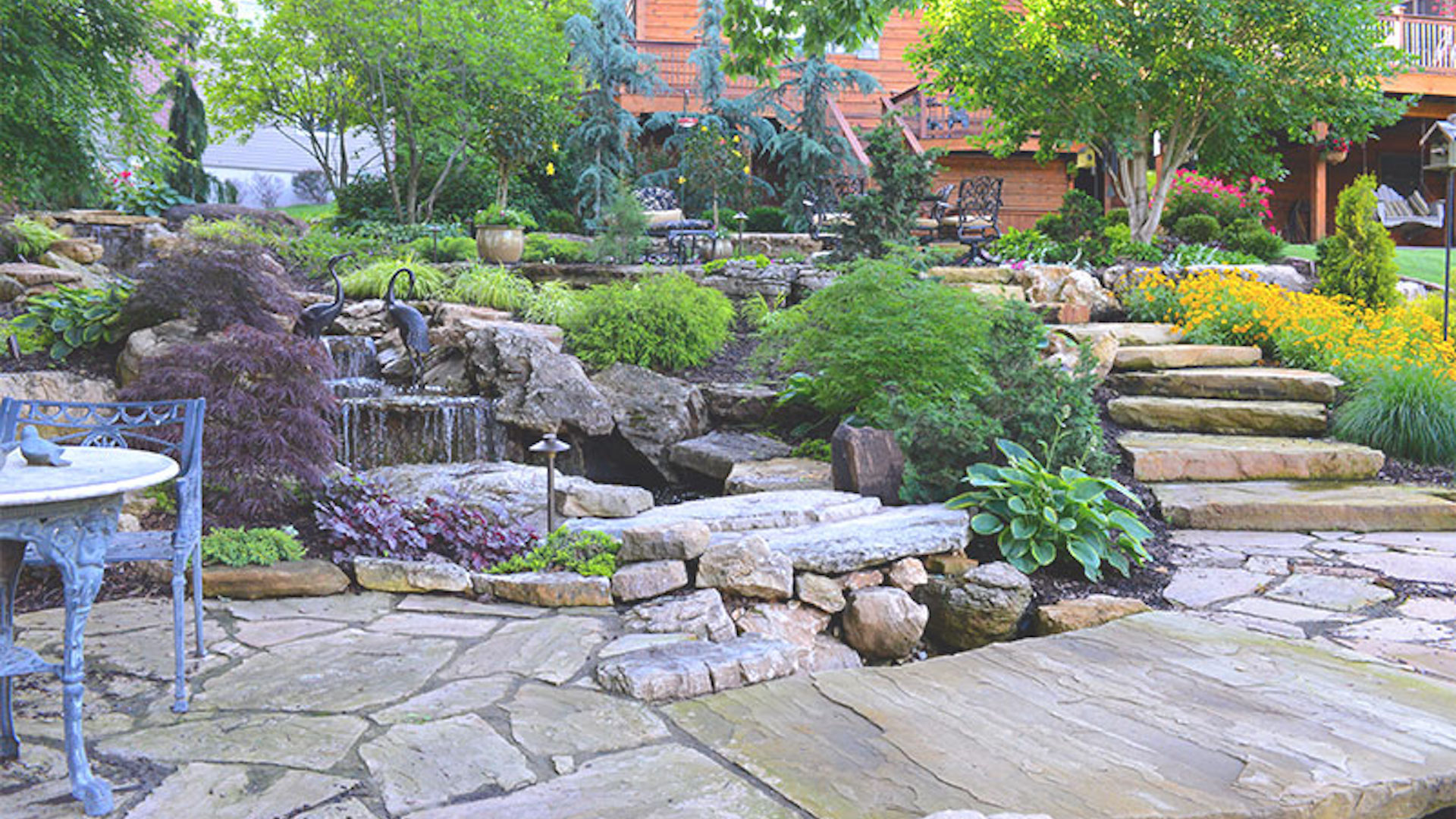Checking Out Different Kinds Of Landscape Design to Enhance Your Outdoor Setting
Landscape design plays a vital function in specifying outdoor spaces. Numerous designs, from traditional yards to contemporary minimal designs, supply distinctive advantages for boosting aesthetics and feature. Integrating components like xeriscaping and native plants can add to environmental equilibrium. Recognizing the interplay of hardscape and softscape is necessary for producing inviting settings. The options readily available can be overwhelming, triggering one to assess which style finest lines up with their vision for an exterior refuge.
Conventional Yard Landscape Design

While many contemporary yards welcome minimalism and indigenous growings, traditional yard landscape design continues to be a cherished strategy that emphasizes balance, structure, and ornamental attributes. This design usually incorporates formal geometric layouts, where flowerbeds, hedges, and pathways are organized with accuracy. Central focal points, such as water fountains or sculptures, draw the eye and provide a sense of harmony.Traditional landscaping regularly consists of a range of plant types, showcasing seasonal flowers and evergreen aspects. Traditional hedges, perennials, and annuals develop vibrant shades and structures throughout the year. Additionally, arches, trellises, and pergolas include upright passion and act as support for climbing up plants, boosting the total aesthetic.The usage of natural products, such as rock and timber, additional improves the traditional landscape, contributing to an ageless top quality. Ultimately, this style welcomes relaxation and pleasure, making it a beloved option for those looking for a stunning outdoor atmosphere.
Modern Minimalist Landscaping
Modern minimalist landscaping highlights simplicity and capability, identified by open spaces and clean lines. Key qualities include a minimal plant scheme and thoughtful hardscape layout that prioritizes use and visual allure. Effective plant choice strategies better enhance the minimalist approach, creating serene exterior atmospheres that encourage relaxation and consideration.
Key Features of Minimalism
A growing fad in landscaping is the welcome of minimalism, defined by simpleness and capability. Minimal landscape design concentrates on clean lines, open spaces, and a limited color combination, advertising a sense of serenity. Elements are very carefully curated to prevent mess, permitting each component to stand out. Using natural materials, such as rock and wood, enhances the organic feeling while maintaining an aesthetic balance. Additionally, minimal designs typically include geometric shapes, which can produce visual rate of interest without overwhelming the senses. Water features may be included, acting as prime focus that enhance peacefulness. Overall, minimalism in landscaping highlights the beauty of restriction, permitting nature's inherent high qualities to radiate through in an unified outside environment.
Plant Selection Approaches
Reliable plant selection is crucial for attaining the desired visual in modern-day minimal landscape design. The focus needs to get on simplicity, using a restricted combination of plants that enhance each various other and the surrounding environment. Indigenous plants are typically suitable, as they call for much less maintenance and water, promoting sustainability. Choosing varieties with varying textures and heights can include aesthetic rate of interest without overwhelming the space. Organizing plants in clusters instead than spreading them boosts cohesion and reinforces the minimalist style. Evergreen ranges can supply year-round framework, while seasonal blooms present refined shade changes. Eventually, the objective is to produce a peaceful outdoor space that embodies peace and consistency with thoughtful plant options.
Hardscape Design Concepts
Vital aspects in hardscape layout significantly add to the overall appearances and performance of minimal landscape design. This style strategy highlights tidy lines and underrated materials, producing a clean aesthetic experience. Key components include pathways, patio areas, and maintaining wall surfaces, which not just specify areas yet likewise enhance availability and usability. The usage of products such as concrete, rock, and wood prevails, reflecting an all-natural yet modern aesthetic. Integrating geometric shapes and symmetrical formats even more reinforces the minimal viewpoint, enabling for a harmonious blend with surrounding plant. In addition, appropriate drainage and erosion control are important considerations, making sure durability and sustainability. Eventually, reliable hardscape layout functions as a foundation that matches softscape elements while maintaining equilibrium and simpleness in outside atmospheres.
Cottage-Style Landscape design
Cottage-style landscape design offers a fascinating method to developing welcoming exterior rooms. By incorporating captivating plant mixes, this design promotes a feeling of heat and fancifulness. The emphasis on comfy, well-defined areas urges leisure and enjoyment of nature.
Lovely Plant Mixes
Although numerous home owners look for to produce an attractive outside room, attaining the beauty of cottage-style landscape design typically depends upon thoughtful plant mixes. Lively blooms, lavish foliage, and fragrant herbs can be skillfully combined to stimulate a sense of fancifulness and fond memories. Integrating lavender, daisies, and foxgloves creates a vivid tapestry that attracts pollinators while providing a fascinating fragrance. Incorporating decorative lawns like miscanthus can include structure and movement, matching the softer blossoms. Furthermore, mixing seasonal and yearly plants warranties continual shade throughout the seasons. Making use of mountain climbers, such as clematis or honeysuckle, can improve vertical interest. Generally, these combinations not only improve the landscape however additionally promote a inviting and charming environment.

Cozy Exterior Rooms
Creating cozy outside rooms needs a cautious blend of convenience and charm, enhancing the vibrant plant mixes found in cottage-style landscaping - Grill Islands. These locations often feature inviting seating plans, such as weathered wood benches or supported chairs bordered by lush greenery. Soft illumination, like fairy lights or lights, includes heat, changing the area into a peaceful resort. Integrating aspects such as trellises embellished with climbing up roses or aromatic herbs boosts sensory experiences. Furthermore, pathways made from rustic stones invite exploration and connection with nature. Ornamental touches like birdbaths or wayward yard art contribute to a feeling of fancifulness. Ultimately, the objective is to create an enchanting ambience that urges relaxation and enjoyment of the charm surrounding these comfy outdoor places
Xeriscaping for Water Conservation
Exactly how can areas stabilize aesthetic landscape design with journalism need for water preservation? Xeriscaping becomes a practical service, promoting lasting practices that reduce water usage while enhancing outside elegance. This landscaping technique concentrates on using drought-resistant plants belonging to the area, which require significantly much less water than typical gardens. By including mulch and effective watering systems, xeriscaping lowers dissipation and overflow, more preserving priceless water resources.Communities can develop visually enticing landscapes via mindful preparation, selecting a varied range of structures and shades that flourish in dry conditions. Furthermore, xeriscaping encourages making use of ornamental rocks and attractive gravel, offering appealing and functional choices to yard yards. As neighborhoods welcome this eco-friendly strategy, they not only minimize their water usage however likewise promote biodiversity and durability in their local communities. Eventually, xeriscaping acts as a demo of the consistency between visual appeal and ecological duty.
Hardscape Layout Elements
Hardscape style elements play an essential function in improving exterior spaces by giving framework and capability. These non-plant attributes, such as outdoor patios, walkways, decks, and wall surfaces, create visual rate of interest while offering sensible purposes. Using products like concrete, brick, and rock, hardscaping adds to the total visual appeal and durability of a landscape.Incorporating hardscape aspects can specify areas within a lawn, assisting activity and motivating social communication. A well-placed pathway can link various sections of the yard, while keeping walls can manage elevation modifications and stop erosion.Furthermore, hardscape style can boost access and safety, providing secure surface areas for strolling or lounging. Efficient combination of hardscape components matches soft landscaping, guaranteeing More Help a well balanced outside setting. Inevitably, thoughtful hardscape layout improves not just the elegance of exterior areas yet also their use, making them extra inviting and practical for visitors and homeowners alike.
Outdoor Living Spaces
While exterior space use a seamless blend of comfort and nature, they function as vital expansions of a home, enhancing way of life and leisure. These locations can include patios, decks, or outdoor kitchens, made to cultivate leisure and amusement. Retaining Wall Installation. By integrating useful furniture and fashionable decor, property owners develop welcoming environments for events or peaceful evenings.The assimilation of color frameworks, such as pergolas or awnings, secures against the components while keeping an open feeling. Fire pits and outside heating systems expand use into cooler months, supplying heat and setting. In addition, integrating lighting features improves the room's usability after sunset, producing a magical evening atmosphere.Landscaping components, such as pathways and boundaries, better define these areas, assisting activity and adding visual appeal. Inevitably, outdoor space change backyards right into functional retreats, advertising a way of living that accepts both nature and convenience
Native Plant Landscaping
Indigenous plant landscape design emphasizes the usage of indigenous vegetation to develop unified and sustainable outside environments. This technique not only improves biodiversity but additionally preserves water and lowers the need for chemical fertilizers and chemicals. By picking plants that are belonging to a specific area, property owners can assure that their landscapes are well-adapted to regional soil and climate problems, leading to lower maintenance requirements.Additionally, native plants provide crucial environments for regional wildlife, consisting of birds, bees, and butterflies, promoting environmental health and wellness. Landscape designs that include these plants commonly feature naturalistic formats that mimic local environments, promoting a sense of area and connection to the environment.Furthermore, indigenous plant landscaping can add to soil stability and disintegration control, making it an eco liable option. Generally, this technique not just enhances outside spaces but additionally sustains the local ecological community, producing a sustainable balance in between human activity and nature.

Often Asked Inquiries
Just How Can I Select the Right Landscape Design Design for My Home?
Selecting the ideal landscape design style for a home includes reviewing the home's design, environment, and individual preferences. Outdoor Lighting Installer. Investigating numerous designs and speaking with specialists can give advice to develop a harmonious outside area customized to specific requirements
What Is the Average Cost of Professional Landscape Design Solutions?
The ordinary expense of expert landscape design solutions normally ranges from $1,000 to $5,000, depending on job intricacy, dimension, and location. Home owners must take into consideration obtaining several quotes to click to read assure they receive fair prices and high quality service.
How Commonly Should I Keep My Landscaped Lawn?
The regularity of preserving a designed lawn commonly relies on the attributes and plants existing. Usually, regular upkeep every couple of weeks is recommended, with seasonal jobs increasing in regularity during peak growing periods for optimal health and aesthetic appeals.
Are There Landscaping Alternatives for Tiny Urban Spaces?

Numerous landscaping options exist for tiny urban spaces, including upright yards, container plants, and roof gardens. Integrating these components can maximize minimal areas while providing greenery, enhancing looks, and enhancing air top quality in urban atmospheres.
What Plants Are Finest for Bring In Neighborhood Wild Animals?
The ideal plants for attracting neighborhood wild animals include indigenous blooming varieties, berry-producing shrubs, and diverse yards. These plants provide essential food and environment, click reference fostering a prospering ecosystem that sustains numerous birds, bugs, and small mammals. Several homeowners look for to create a picturesque outdoor area, achieving the beauty of cottage-style landscape design often pivots on thoughtful plant mixes. Developing comfortable exterior areas needs a mindful blend of convenience and charm, enhancing the dynamic plant combinations located in cottage-style landscape design. Native plant landscaping highlights the usage of indigenous flora to create sustainable and harmonious outside environments. Landscape creates that incorporate these plants frequently feature naturalistic layouts that resemble regional environments, cultivating a sense of location and connection to the environment.Furthermore, native plant landscaping can contribute to soil stability and erosion control, making it an environmentally liable choice. Different landscaping options exist for small urban spaces, including vertical gardens, container plants, and rooftop yards.